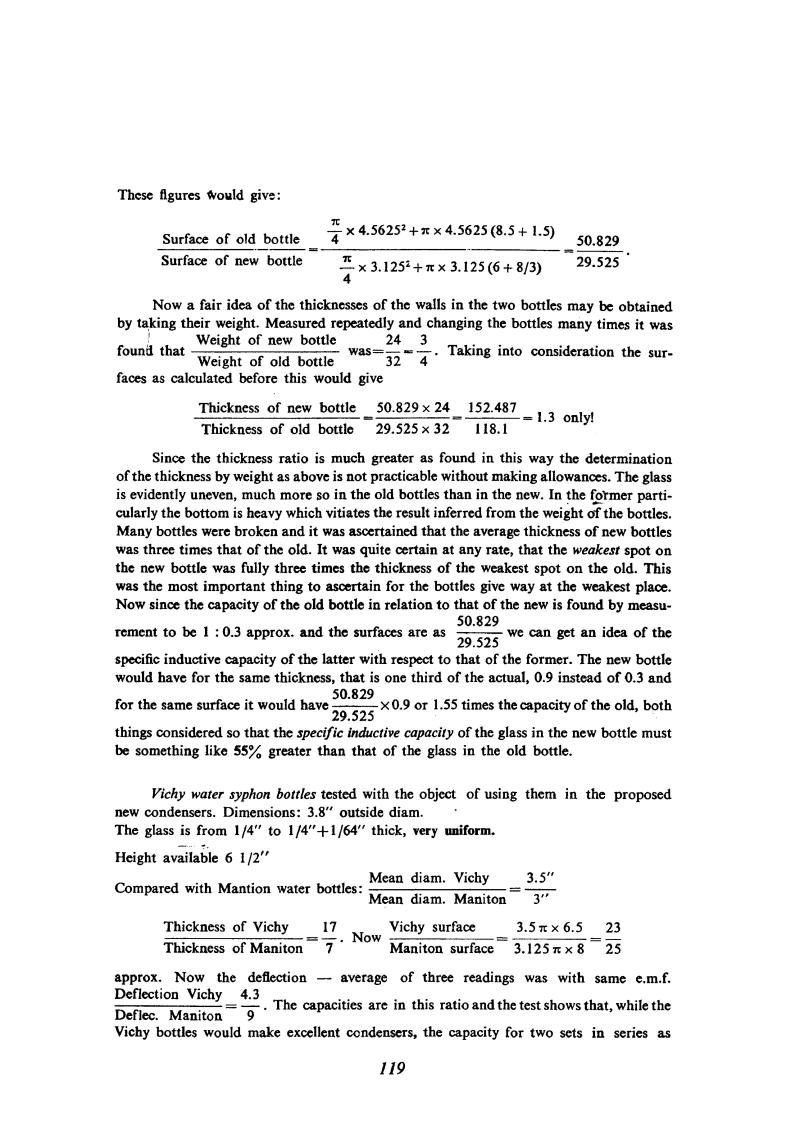
Nikola Tesla Books
These figures would give:
$! {{\text{Surface of old bottle} \over \text{Surface of new bottle}} = {{{\pi \over 4} \times 4.5625^{2} + \pi \times 4.5625 (8.5 + 1.5)} \over {{\pi \over 4} \times 3.125^{2} + \pi \times 3.125 (6 + 8/3)}} = {50.829 \over 29.525}} $!.
Now a fair idea of the thicknesses of the walls in the two bottles may be obtained by taking their weight. Measured repeatedly and changing the bottles many times it was $! {\text{Weight of new bottle} \over \text{Weight of old bottle}} $! was $! {= {24 \over 32} = {3 \over 4}} $!. Taking into consideration the surfaces as calculated before this would give
$! {{\text{Thickness of new bottle} \over \text{Thickness of old bottle}} = {{50.829 \times 24} \over {29.525 \times 32}} = {152.487 \over 118.1} = 1.3} $! only!
Since the thickness ratio is much greater as found in this way the determination of the thickness by weight as above is not practicable without making allowances. The glass is evidently uneven, much more so in the old bottles than in the new. In the former particularly the bottom is heavy which vitiates the result inferred from the weight of the bottles. Many bottles were broken and it was ascertained that the average thickness of new bottles was three times that of the old. It was quite certain at any rate, that the weakest spot on the new bottle was fully three times the thickness of the weakest spot on the old. This was the most important thing to ascertain for the bottles give way at the weakest place. Now since the capacity of the old bottle in relation to that of the new is found by measurement to be 1:0.3 approx. and the surfaces are as $! {50.829 \over 29.525} $! we can get an idea of the specific inductive capacity of the latter with respect to that of the former. The new bottle would have for the same thickness, that is one third of the actual, 0.9 instead of 0.3 and for the same surface it would have $! {50.829 \over {29.525 \times 0.9}} $! or 1.55 times the capacity of the old, both things considered so that the specific inductive capacity of the glass in the new bottle must be something like 55% greater than that of the glass in the old bottle.
Vichy water syphon bottles tested with the object of using them in the proposed new condensers. Dimensions: 3.8" outside diam.
The glass is from 1/4" to 1/4" + 1/64" thick, very uniform.
Height available 6 1/2"
Compared with Mantion water bottles: $! {{\text{Mean diam. Vichy} \over \text{Mean diam. Maniton}} = {3.5\text{"} \over 3 \text{"} }} $!
$! {{{\text{Thickness of Vichy} \over {\text{Thickness of Maniton}}} = {17 \over 7}}} $!. Now $! {{\text{Vichy surface} \over \text{Maniton surface}} = {{3.5 \pi \times 6.5} \over {3.125 \pi \times 8}} = {23 \over 25}} $!
approx. Now the deflection - average of three readings was with same e.m.f. $! {{\text{Deflection Vichy} \over \text{Deflec. Maniton}} = {4.3 \over 9}} $!. The capacities are in this ratio and the test shows that, while the Vichy bottles would make excellent condensers, the capacity for two sets in series as
119
July 31
Tesla made the capacitors for primary circuit from mineral water bottles filled with a saturated solid salt solution. He then submerged several bottles in a metal tank filled with the same solution. By that method he obtained the capacitor groups with a common layer. Other layers (electrolyte in jars) could have been connected in parallel as desired. The least capacitance change of capacitor battery of this type amounted to exactly the capacitance of one jar. By performing the withstand tests on such capacitors at a frequency of 144 Hz he concluded that they could withstand even 30,000 volts when two series of them are connected in series. By so solving the capacitor problems in primary circuit, he returns again to the secondary circuit. In the secondary he hadn't yet solved the problem of coil distributed capacitance, in which he sees the main obstacle on the way of achievement of desirable high voltages. Tesla's analysis, somewhat strange for a reader of these days (sometimes even incorrect) as hosed on a limited number of facts, impressed with its breadth. Tesla deeply penetrates in physical processes, and attempts to understand what and how something happens. His experiments provide him with proofs for conclusions he came to on the basis of thinking and analysis of previous experiments.
By having a desire to design the secondary coil with minimal self-capacitance, and which will be able to operate at extraordinary high voltages, Tesla devoted his time, more than anybody else before him, to a study of coils. The results were not lacking (coil shapes, winding methods), but with all that Tesla was not satisfied. He thinks what would happen when he would add series capacitors, and what would happen if he could change the distance between windings, or the wire diameter, etc.

